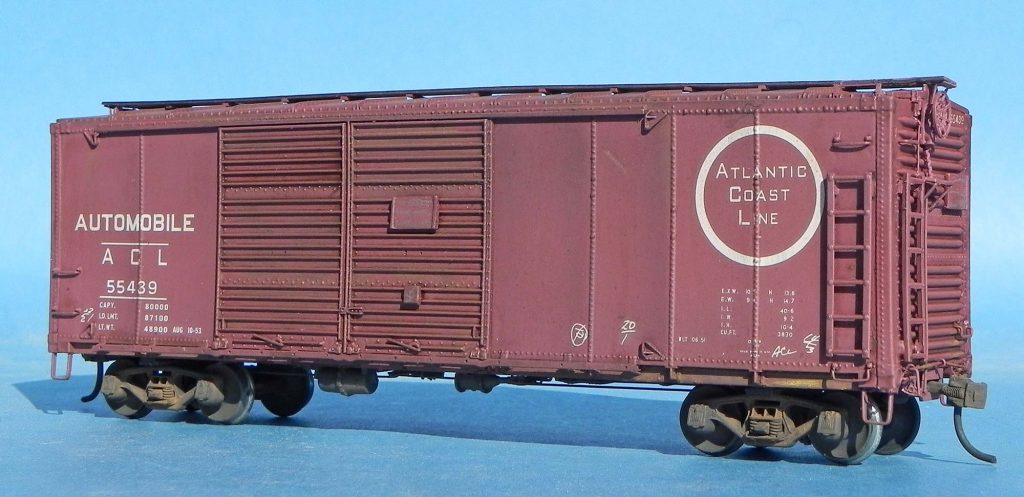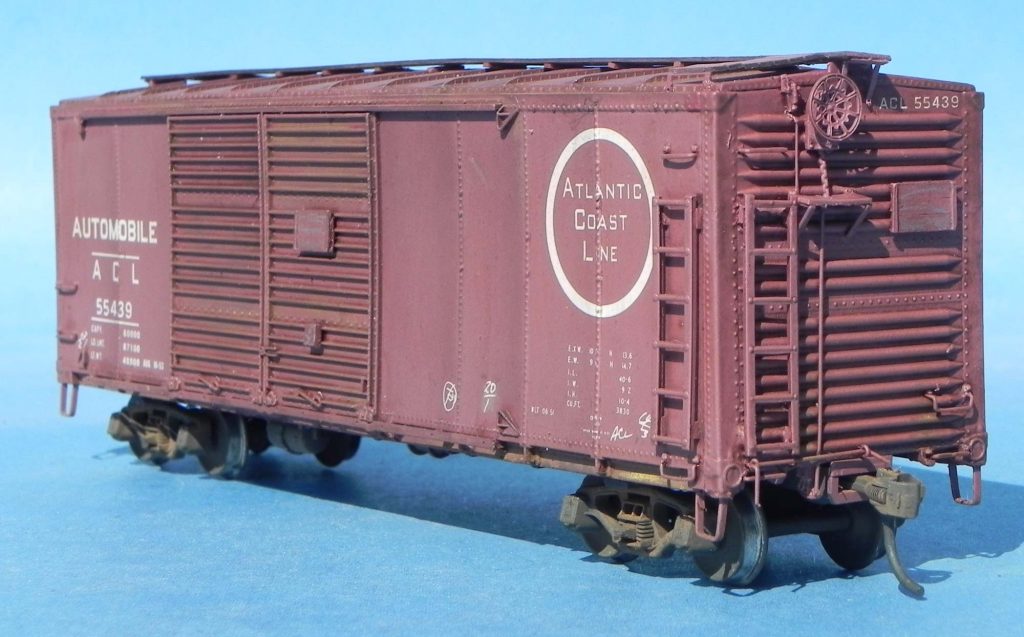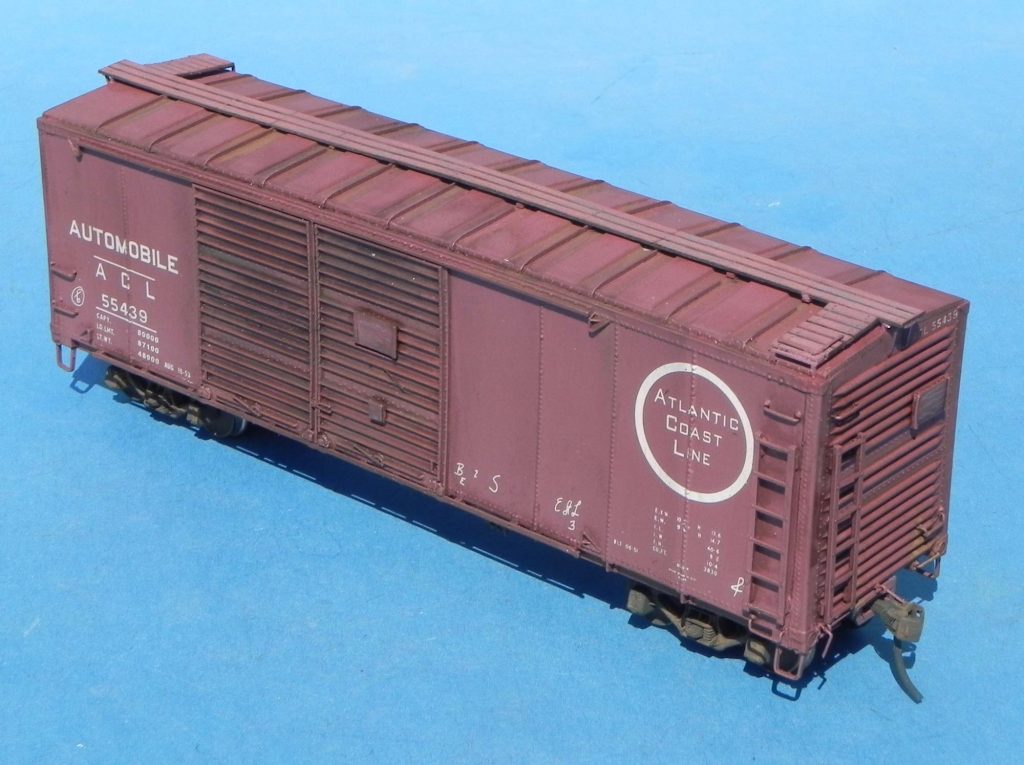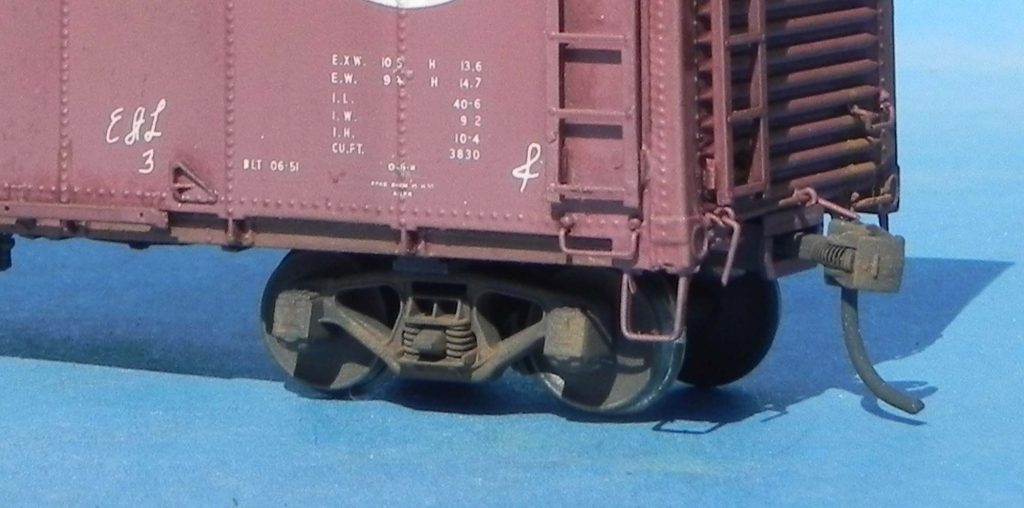Bob Chapman sent photos and details on a Yarmouth Model Works Atlantic Coast Line automobile boxcar he recently finished. Here’s Bob with more.
I’ve always been attracted to 40-foot, double-door auto cars; there’s a certain charm to that stubby, all-door look. When I saw Pierre’s kit at Chicagoland, it was impossible to pass up.
The Yarmouth Model Works ACL class O-16-B auto car has a one-piece resin carbody cast from a 3D printed master. It is a very well executed kit.
The prototype is a rebuild of ACL’s early-20s single-sheathed O-16 boxcars, which were similar to the USRA design. The ACL added 3,700 of these cars in 1923 as their first 40-foot boxcars. The single-sheathed cars were rebuilt into the B-series in 1940-41, and a few of “B” rebuilds lasted into the 80s.
The model was built as a “layout model.” I built it to look good in a consist on the layout but it lacks a completeness of detail. I replaced YMW’s very nice photo-etched ladder “minikits” with off-the-shelf styrene ladders. YMW’s ladders do look better on close inspection, but on the layout, I have trouble telling the difference. For me, it’s an effort-benefit thing. Plus, I don’t want all the completed resin kits with styrene ladders to suddenly feel second-class.
My construction followed the instruction sheet with a few exceptions.
⦁ Substituted A-Line sill steps for YMW’s photo-etched parts
⦁ Omitted the air hoses as Kadee auto couplers are still my standard
⦁ Substituted a Kadee brake wheel, which I felt was an improvement over the Tichy part
Weathering
What I enjoy spending time on are the things that people notice when they look at a model; craftsmanship, painting, and weathering. I try to weather each car individually so there will be prototypical variety when they appear in a consist. Before I start, I do a bit of thinking about how much weathering and what type of look I want for the finished model. I vary the weathering media with different brands of powders, different colors of oil paint or acrylic washes, roof treatment, etc.
For the O-16-B, I wanted the car to look ready for the paint shop — faded, grimy, and heavily weathered. I used pretty much the whole portfolio of techniques, starting with a very light over spray of very dilute body color to fade the lettering. Next was a very thin wash of burnt umber oil-based paint to add grime deposits in the crevices and a bit of grime to the surface areas. The sheathing seams were highlighted using Greg Martin’s Post-It technique with Testor’s Rubber. Dullcoat was next, followed by some final highlighting with AIM powders and Prismacolor pencils.
Truck Sideframes
I paint the truck sideframes and wheels with Scalecoat 2 Grimy Black. A very thin over spray follows using a mix of Rust and Roof Brown. I want to represent a darker brown, not an orangy rust look. The spray is very thin on the wheels — just enough to give them that slightly yellowed appearance of caked oil. A little more is sprayed onto the sideframes — enough for an overall somewhat rusted appearance; I try not to totally hide the Grimy Black.
After painting the sideframes, Dullcote is applied to give some tooth for the weathering powder to adhere. I like to highlight the sideframes with AIM weathering powders. I used Medium Earth on the O-16-B.
While I may have made the weathering process sound like an engineering project, it’s not. Let your artist’s eye do the work.
Thanks to Bob Chapman for sharing his techniques to bring this ACL boxcar into layout service. Questions and comments can be posted below. Please follow the instructions so your comment can be posted. All comments are reviewed and approved before they appear. To subscribe to this blog, add your email address to the function at the bottom of the right column on the main page. Share the blog link with other model railroaders.






Bob,
You know for me this comment says it all for my modeling, albeit there are times when I go over the top. Typically great work from a great modeler and friend.
“What I enjoy spending time on are the things that people notice when they look at a model; craftsmanship, painting, and weathering. I try to weather each car individually so there will be prototypical variety when they appear in a consist. ”
With tongue in cheek I have to ask, was there any terminology here that made your modeling better or worst? Like running board vs walk way? Just kidding! 3^)
Bob as always great work and thanks for being a great mentor over the many years.
Perhaps we’ll see each other in Cocoa Beach this January?
Hey Guys,
Has nobody noticed the MAJOR Safety Appliance Act violation displayed on this model? It jumps out in the corner detail photo meant to show something which I, for the life of me, can’t see on my 21.5″ monitor. Pierre started it, but Bob pushed it into the realm of “what the f . . . ??”
(Sorry for the display of potentially bad language, but that word I had in mind of course, was fruitcake.)
BSR, RPA
Tom Christensen writes:
A very nicely done model. Only it’s numbered for an O-16-A….
Tom is right, and even worse, so is YMW’s instruction sheet. The trap is in the decals, with the only 55xxx number provided being late in the “A” series, a few digits below the “B’s”. A few surplus digits are provided, allowing the decal to be pieced to correctly do a “B”. Note to self — don’t decal late at night. Tom — thanks for the correction.
Bob Chapman
A very nicely done model. Only it’s numbered for an O-16-A, which had different side panel configuration, side sill, and side ladder. Also ACL had subtle lettering changes depending on era.
Hello…
I just saw your ACL RR 40 Foot Boxcar and it looks “nice”.
Richard Young.
Bob
That’s a great looking model and the weathering is excellent